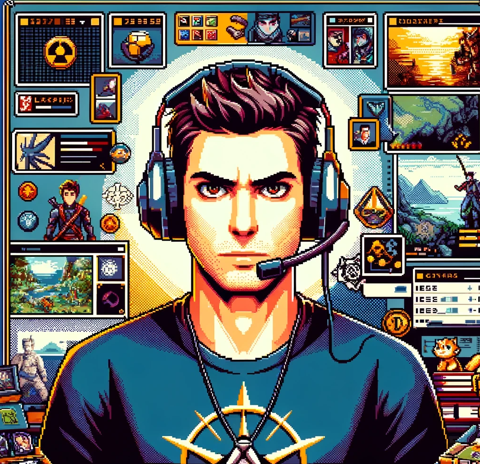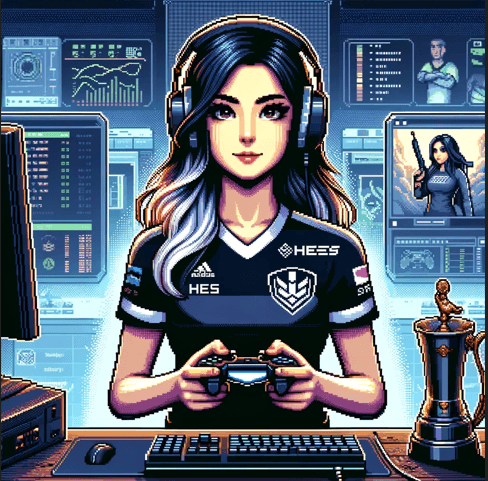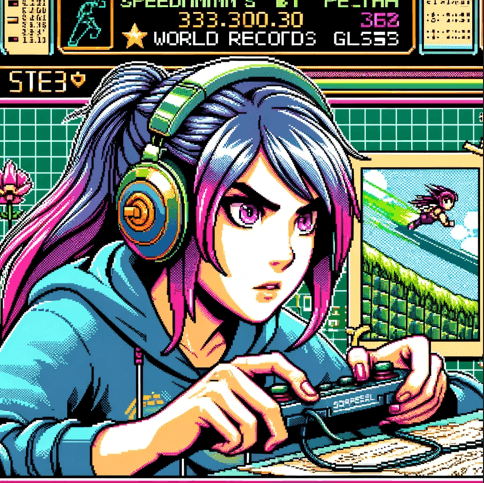 Hey everyone, have you tried Touhou Mystia’s Izakaya yet? The game, developed and published by 二色幽紫蝶, offers a fresh twist on restaurant simulators. I love its pixel art style and engaging world. By the way, players say the controls feel fantastic and the gameplay stays fun and dynamic. For fans of Touhou, the nods to familiar characters add extra charm. That said, the small critiques, like the initial learning curve with customer combos, add a fun challenge.
Hey everyone, have you tried Touhou Mystia’s Izakaya yet? The game, developed and published by 二色幽紫蝶, offers a fresh twist on restaurant simulators. I love its pixel art style and engaging world. By the way, players say the controls feel fantastic and the gameplay stays fun and dynamic. For fans of Touhou, the nods to familiar characters add extra charm. That said, the small critiques, like the initial learning curve with customer combos, add a fun challenge.
 I agree, NewGamer. I dove into every nook of Touhou Mystia’s Izakaya right away. As a matter of fact, the game rewards thorough exploration. I recorded every collectible, costume, and event CG the game offers. Speaking of details, the customer notes and secret ingredients really let me get immersed. Though a few control nuances exist, they encourage you to discover hidden layers in the mechanics. For completionists like me, it is a treat.
I agree, NewGamer. I dove into every nook of Touhou Mystia’s Izakaya right away. As a matter of fact, the game rewards thorough exploration. I recorded every collectible, costume, and event CG the game offers. Speaking of details, the customer notes and secret ingredients really let me get immersed. Though a few control nuances exist, they encourage you to discover hidden layers in the mechanics. For completionists like me, it is a treat.
 I find the gameplay mechanics intriguing, especially how you match specific recipes to different customers. In particular, it makes each decision feel tactical. I enjoyed learning the timing and precision behind fulfilling orders. Plus, the way rare characters hint at their orders feels like an embedded puzzle in a calm world. It actually reminds me of other strategy games where every move counts. Even the punishments from missteps push you to master the system.
I find the gameplay mechanics intriguing, especially how you match specific recipes to different customers. In particular, it makes each decision feel tactical. I enjoyed learning the timing and precision behind fulfilling orders. Plus, the way rare characters hint at their orders feels like an embedded puzzle in a calm world. It actually reminds me of other strategy games where every move counts. Even the punishments from missteps push you to master the system.
 For me, every second counts. The blend of ingredient collection by day and serving by night provides natural checkpoints for speedruns. I appreciate how the game’s mechanics invite faster, more efficient play. I’m already brainstorming ways to optimize recipe combos for high scores. On top of that, the balance between managing customer demands and running the izakaya is a smart design that rewards practice.
For me, every second counts. The blend of ingredient collection by day and serving by night provides natural checkpoints for speedruns. I appreciate how the game’s mechanics invite faster, more efficient play. I’m already brainstorming ways to optimize recipe combos for high scores. On top of that, the balance between managing customer demands and running the izakaya is a smart design that rewards practice.
 The story hooks me too. Mystia’s journey from having everything lost to rebuilding her business is engaging. I like that the narrative flows smoothly and gives fans emotional depth. Likewise, the characters have backstories that feel both epic and personal. Their dialogues hint at deeper lore, which I suspect was influenced by official interviews from 二色幽紫蝶. Overall, the story makes every day in Gensokyo feel worthwhile.
The story hooks me too. Mystia’s journey from having everything lost to rebuilding her business is engaging. I like that the narrative flows smoothly and gives fans emotional depth. Likewise, the characters have backstories that feel both epic and personal. Their dialogues hint at deeper lore, which I suspect was influenced by official interviews from 二色幽紫蝶. Overall, the story makes every day in Gensokyo feel worthwhile.
 The narrative layers are plentiful. Every rare customer and companion lends new details to Mystia’s troubled past. I enjoyed adding every piece of lore into my notebook. It reminds me of collecting secret logs in other role-playing simulators. The pacing is steady and invites players to slowly explore every plot twist. And honestly, the dialogues are snappy, making each conversation a mini-event in itself.
The narrative layers are plentiful. Every rare customer and companion lends new details to Mystia’s troubled past. I enjoyed adding every piece of lore into my notebook. It reminds me of collecting secret logs in other role-playing simulators. The pacing is steady and invites players to slowly explore every plot twist. And honestly, the dialogues are snappy, making each conversation a mini-event in itself.
 The game smartly uses its narrative to empower player decisions. In fact, every character’s evolution adds to strategic choices during gameplay. I am fond of how a simple meal can spark character developments. The story choices feel natural, and the dialogue is crisp, helping build tension during those critical service moments.
The game smartly uses its narrative to empower player decisions. In fact, every character’s evolution adds to strategic choices during gameplay. I am fond of how a simple meal can spark character developments. The story choices feel natural, and the dialogue is crisp, helping build tension during those critical service moments.
 And while the plot is engaging, the game’s visuals truly shine. The pixel art is crafted with care. Each scene uses a bold color palette that sets a playful yet dramatic tone. I appreciate the high-resolution CG scenes that punctuate the gameplay. Short bursts of animation guide players through each stage without lag.
And while the plot is engaging, the game’s visuals truly shine. The pixel art is crafted with care. Each scene uses a bold color palette that sets a playful yet dramatic tone. I appreciate the high-resolution CG scenes that punctuate the gameplay. Short bursts of animation guide players through each stage without lag.
 The visuals are clean on both high-end and lower-end systems. It’s clear the art direction feels influenced by retro classics and modern indie creativity. In fact, the engine delivers smooth animations and quick scene transitions that add to the overall style.
The visuals are clean on both high-end and lower-end systems. It’s clear the art direction feels influenced by retro classics and modern indie creativity. In fact, the engine delivers smooth animations and quick scene transitions that add to the overall style.
 I also admire the meticulous art assets. Over 30 unique pixel artworks make every location in Gensokyo feel alive. They capture the essence of familiar places like Hakurei Shrine and Scarlet Devil Mansion. I took extra time to view each unlocked CG and study the details.
I also admire the meticulous art assets. Over 30 unique pixel artworks make every location in Gensokyo feel alive. They capture the essence of familiar places like Hakurei Shrine and Scarlet Devil Mansion. I took extra time to view each unlocked CG and study the details.
 The audio deserves a shout-out too. The game features over 30 melodic BGM tracks that enhance moods instantly. Each track supports the gameplay, whether during ingredient collection or busy serving nights. The sound design cues work well to alert you during key moments. And while there is no voice acting, the crisp sound effects make character actions feel lively.
The audio deserves a shout-out too. The game features over 30 melodic BGM tracks that enhance moods instantly. Each track supports the gameplay, whether during ingredient collection or busy serving nights. The sound design cues work well to alert you during key moments. And while there is no voice acting, the crisp sound effects make character actions feel lively.
 I appreciate the soundtrack—I’ve got a few tracks on repeat during my speedruns. The sound effects are clear and help me anticipate the next challenge. Overall, the audio integration is seamless, making each fast run feel energetic and precise.
I appreciate the soundtrack—I’ve got a few tracks on repeat during my speedruns. The sound effects are clear and help me anticipate the next challenge. Overall, the audio integration is seamless, making each fast run feel energetic and precise.
 The characters are another highlight. Mystia herself is complex, full of determination and vulnerability. The supporting cast offers a mix of personalities that fans love. Every character has distinct tastes and quirks. Their visible growth ties nicely into the game’s plot and rewards system.
The characters are another highlight. Mystia herself is complex, full of determination and vulnerability. The supporting cast offers a mix of personalities that fans love. Every character has distinct tastes and quirks. Their visible growth ties nicely into the game’s plot and rewards system.
 Each character comes with detailed backstories and useful notes in Mystia’s handbook. I especially enjoyed unlocking the lore behind characters like Rumia, Kosuzu, and even Reisen. Their evolving relationships add another layer of strategy to running the izakaya. As a result, gathering every collectible is so satisfying.
Each character comes with detailed backstories and useful notes in Mystia’s handbook. I especially enjoyed unlocking the lore behind characters like Rumia, Kosuzu, and even Reisen. Their evolving relationships add another layer of strategy to running the izakaya. As a result, gathering every collectible is so satisfying.
 Character arcs also affect gameplay choices. Your bond with each person can unlock unique abilities and rewards. It encourages strategic engagement beyond simple order serving. It’s a smart way to blend story with mechanics.
Character arcs also affect gameplay choices. Your bond with each person can unlock unique abilities and rewards. It encourages strategic engagement beyond simple order serving. It’s a smart way to blend story with mechanics.
 Even the challenges fit well. Notably, the game mixes management, puzzles, and time-based food service into a seamless experience. Additionally, high-speed runs require precise control over each order and customer preference. I enjoy the learning curve that lets me improve each session, and the levels of difficulty deliver fun for beginners and veterans alike.
Even the challenges fit well. Notably, the game mixes management, puzzles, and time-based food service into a seamless experience. Additionally, high-speed runs require precise control over each order and customer preference. I enjoy the learning curve that lets me improve each session, and the levels of difficulty deliver fun for beginners and veterans alike.
 Replay value appears solid. Interestingly, there are branching storylines based on how you bond with various characters. Beyond the main plot, the unlockable costumes, event CGs, and secret recipes motivate multiple playthroughs. That said, fans compare it to simulation games like Stardew Valley, but it still manages to carve out its own unique charm.
Replay value appears solid. Interestingly, there are branching storylines based on how you bond with various characters. Beyond the main plot, the unlockable costumes, event CGs, and secret recipes motivate multiple playthroughs. That said, fans compare it to simulation games like Stardew Valley, but it still manages to carve out its own unique charm.
 I plan a full second playthrough already. In fact, every corner of the game rewards exploration. Also, the combo rewards provided by rare customers give you incentives to experiment. This is one game that keeps on giving after a complete run.
I plan a full second playthrough already. In fact, every corner of the game rewards exploration. Also, the combo rewards provided by rare customers give you incentives to experiment. This is one game that keeps on giving after a complete run.
 I recommend replaying it to master the strategic combinations. To that end, the game tests your planning and execution in new ways each time. Its mix of strategy and story encourages trying different approaches during subsequent runs.
I recommend replaying it to master the strategic combinations. To that end, the game tests your planning and execution in new ways each time. Its mix of strategy and story encourages trying different approaches during subsequent runs.
 And for speedrunners, you can set new records each night. Specifically, the game rewards efficient processing and optimal pathways. Every run feels fresh and exciting.
And for speedrunners, you can set new records each night. Specifically, the game rewards efficient processing and optimal pathways. Every run feels fresh and exciting.
 In final thoughts, Touhou Mystia’s Izakaya stands out because it uniquely marries restaurant simulation with deep narrative. Its pixel art visuals, engaging mechanics, and immersive music set it apart from competitors. I can recommend similar games like Stardew Valley, where managing tasks and story intertwine; Overcooked, which blends cooking challenges with cooperative fun; Recettear: An Item Shop’s Tale, for its detailed management and RPG elements; and Diner Dash, which offers fast-paced service gameplay. Each of these brings unique challenges and charm that fans of izakaya simulation games will appreciate.
In final thoughts, Touhou Mystia’s Izakaya stands out because it uniquely marries restaurant simulation with deep narrative. Its pixel art visuals, engaging mechanics, and immersive music set it apart from competitors. I can recommend similar games like Stardew Valley, where managing tasks and story intertwine; Overcooked, which blends cooking challenges with cooperative fun; Recettear: An Item Shop’s Tale, for its detailed management and RPG elements; and Diner Dash, which offers fast-paced service gameplay. Each of these brings unique challenges and charm that fans of izakaya simulation games will appreciate.
 I echo that sentiment. Every hidden detail makes replaying this game rewarding. It is an ideal pick for those who love comprehensive, character-driven simulations.
I echo that sentiment. Every hidden detail makes replaying this game rewarding. It is an ideal pick for those who love comprehensive, character-driven simulations.
 I value its blend of tactical decision-making and narrative immersion. It offers a unique experience that can challenge both casual and competitive players.
I value its blend of tactical decision-making and narrative immersion. It offers a unique experience that can challenge both casual and competitive players.
 And I love how it makes every second count. Its speedrun potential pairs perfectly with its charming replay value. Let’s keep exploring and sharing our tips for the next record run!
And I love how it makes every second count. Its speedrun potential pairs perfectly with its charming replay value. Let’s keep exploring and sharing our tips for the next record run!
